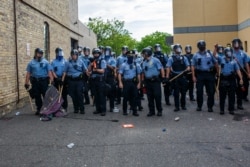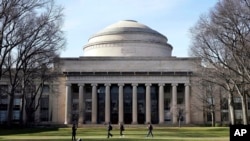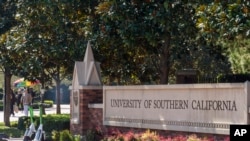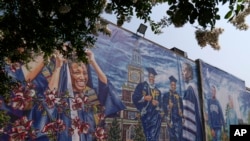Student Union
On Racism, Young Americans Say Change Takes Effort
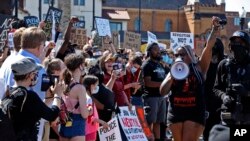
Raequan Johnson is upset. And so are most of his young friends, he says.
The death of African American George Floyd while in police custody in Minneapolis is the most recent reminder Johnson says of the change needed in the United States.
Floyd was held to the ground with a policeman’s knee on his neck for more than eight minutes.
“I’m disappointed at how long it’s taking us to abolish racial profiling and discrimination,” the 19-year old says. “Racial profiling needs to stop.”
Racial profiling occurs when a police or other law enforcement officer assumes or suspects something about a person because of their race or ethnicity. Statistics vary by jurisdiction, but some show that people of color are arrested from three to 10 times the rate of white Americans in various U.S. cities.
“This has been going on for generations, and we are tired of it. How many more lives have to be taken due to this?” Johnson asks.
After the video of Floyd’s street arrest circulated, millions of people — first, mostly people of color, then joined by whites and other ethnicities — turned out in street protests around the world against racism and the use of excessive force by police and law enforcement.
Young Americans have been front and center on those lines.
“The best way for us to go about all of this is to stand together in a way that helps the movement overall,” says D’Andre Leid, 18, a senior at Eleanor Roosevelt High School in suburban Washington.
Social media was a flurry of young activists like 21-year-old Aliya Cruise, who is posting ways to raise awareness about police brutality and discrimination in the U.S.
“I am avid on social media. … I sign petitions, as well as donate to causes whenever I can,” says Cruise in an email. “I do the homework, too, and try to stay informed on as many topics as possible.”
“Now that I am of age, I try to vote for officials I see as best for the job and will see the bigger picture, including #BLM,” referencing the anti-racism movement, Black Lives Matter.
As a child, Cruise says, her family discussed race, ethnicity and identity regularly. Her mother is Afro-Latina racially and Puerto Rican ethnically. Her father is black and Irish.
“I was raised in an environment that did not hate ... I learned about racism, sexism and homophobia, and the implications from a very young age. I didn't like these concepts at all,” Cruise notes. “I know what it's like to be judged, simply based on outward appearances and nothing about my intellect or what's in my heart.”
In addition to mobilizing other young people on social media, Cruise is active in Stetson University’s Black Student Association and has served on the university’s Multicultural Student Council, the Caribbean Student Association, and the Woke Independent Student Empowerment program, among others.
“We will still experience these problems if nothing changes. That's why the conversation and the fight must continue, and everyone is responsible to engage in that conversation …,” she says. “Why shouldn't I do my part?”
In-depth statistics that detail deaths in police custody are difficult to obtain. A black man in the U.S. has an estimated 1 in 1,000 chance of being killed by police during his lifetime, according to a paper published in August 2019 in the Proceedings of the National Academy of Sciences.
That’s 2.5 times higher than what a non-Hispanic white man experiences, the authors states.
Black women, the paper stated, are 1.4 times more likely than white women to be killed by police. Men overall are 20 times more likely than women to be killed by police.
“Across the nation, law enforcement and the communities they serve continue to come together in mutual respect,” the National Law Enforcement Museum in Washington posted on its Facebook page.
“Personally, I feel like it takes every person doing their part,” says Leid. “So, targeting your skills or your focus towards change whatever way that may be is how you do it.”
As for Cruise, her message to her peers is clear.
“I hope our youth realizes that this is not a trend,” Cruise says. “This is a lifelong struggle people have to deal with, and this is not the beginning, nor is it the end of that struggle.”
See all News Updates of the Day
US remains top choice for Indian students going abroad

About 69% of Indian students traveling abroad for their studies chose the United States, according to a Oxford International’s Student Global Mobility Index. Other popular choices were the United Kingdom, Canada and Australia.
Education Times reports the main influencers for deciding where to study abroad – for Indian students and others – were parents. (April 2024)
Malaysian official: Schools can’t turn away from global tensions

Zambry Abdul Kadir, Malaysia’s higher education minister, said protests spreading across universities in the United States show that schools can’t ignore political tensions.
Helen Packer, reporting in Times Higher Education, said the minister reminded educators that universities are key in the development of leaders, individuals and societies. (April 2024)
Social media breaks are difficult, but necessary

Between online classes, maintaining social connections and working on projects, college students can have a hard time disengaging from the demands of technology.
In Florida International University’s PantherNOW, Ariana Rodriguez offers strategies for taking a break from social media. (April 2024)
- By Melos Ambaye
Many master's degrees aren't worth the investment, research shows

Nearly half of master's degrees have a negative financial return, according to new research by the Foundation for Research on Equal Opportunity, an economic research organization.
The study indicates that many graduate degree programs do not increase lifetime earnings enough to be worth it.
While 23% of bachelor’s degree programs yield a negative financial return on investment, 43% of two-year degrees and master’s degrees fail to deliver a return, according to the study by Preston Cooper, a senior fellow at FREOPP.
Cooper assessed the return on investment for 53,000 degree and certificate programs to determine whether a student’s lifetime earnings outweigh program costs and the risk of not completing their degree.
His findings show that a student’s field of study was the overriding indicator of return on investment at the undergraduate and graduate level.
Engineering, computer science and nursing bachelor’s degrees have high financial returns on investment, while programs in education, fine arts, psychology and English usually have low returns.
Graduate degrees in medicine and law tend to have strong payoffs. But a large share of master’s programs, including the MBA, frequently have low payoffs, according to Cooper.
Although workers with master’s degrees earn 16% more than those with only bachelor’s degrees, Cooper says the figure fails to account for students who had “higher preexisting earnings potential.”
“MBA students typically have high preexisting earnings potential, having often chosen high-ROI undergraduate majors such as finance and economics,” Cooper writes. “So the MBA adds little value on top of that.”
The study indicates that high starting salaries are predictors of high returns on investment. Degrees with starting salaries of $57,000 a year or more deliver the best lifetime returns.
But the return on investment of a degree can vary depending on the educational institution.
“Students interested in fields with low average pay can still find some schools that do well transforming those fields of study into high-paying careers,” Cooper writes.
The quality of an institution also matters, said William Tierney, professor emeritus of higher education at the University of Southern California.
“An MBA from Harvard is a likely ticket to a good job,” Tierney told VOA. “An MBA from the University of Phoenix, less so.”
But students pursue graduate programs for more than just financial reasons.
“Some degrees open up careers in fields that students may enjoy, such as in the performing arts,” Robert Kelchen, head of educational leadership at the University of Tennessee, Knoxville, told VOA.
“Others can help gain access to social networks or simply help students learn about a topic that is of interest,” Kelchen added.
Cooper told VOA that it might make sense for students in degree programs with low returns on investment to switch majors if they can still graduate on time.
He found the worst outcome for a student’s return on investment is dropping out of college “because they must pay for one or more years’ tuition and spend time out of the labor force.”
Lawmakers who fund higher education have a responsibility in ensuring “higher education delivers on its promise of economic mobility,” Cooper said.
Nearly a third of federal funding, including Pell grants and student loans, pays for higher education programs that fail to provide students with a return on investment, according to the study.
Cooper’s view is that “some schools should shut down low-ROI programs and reallocate institutional resources to programs with a better return.”
“There's definitely this narrative out there that higher education is always worth it, and you should always try to get that extra degree because it will increase your earnings,” he told VOA. “That's reinforced by colleges who make lofty promises regarding their graduate degree programs' outcomes, which all too often fall short.”
Harvard students end protest as school agrees to discuss Gaza conflict

Protesters against the war between Israel and Hamas were voluntarily taking down their tents in Harvard Yard on Tuesday after university officials agreed to discuss their questions about the endowment, bringing a peaceful end to the kinds of demonstrations that were broken up by police on other campuses.
The student protest group Harvard Out of Occupied Palestine said in a statement that the encampment "outlasted its utility with respect to our demands." Meanwhile, Harvard University interim President Alan Garber agreed to pursue a meeting between protesters and university officials regarding the students' questions.
Students at many college campuses this spring set up similar encampments, calling for their schools to cut ties with Israel and businesses that support it.
The Israel-Hamas war began when Hamas and other militants stormed into southern Israel on October 7, killing some 1,200 people and taking 250 hostages. Palestinian militants still hold about 100 captives, and Israel's military has killed more than 35,000 people in Gaza, according to Gaza's Health Ministry, which doesn't distinguish between civilians and combatants.
Harvard said its president and the dean of the Faculty of Arts and Sciences, Hopi Hoekstra, will meet with the protesters to discuss the conflict in the Middle East.
The protesters said they worked out an agreement to meet with university officials, including the Harvard Management Company, which oversees the world's largest academic endowment, valued at about $50 billion.
The protesters' statement said the students will set an agenda that includes discussions on disclosure, divestment, reinvestment and the creation of a Center for Palestine Studies. The students also said that Harvard has offered to retract suspensions of more than 20 students and student workers and back down on disciplinary measures faced by 60 more.
"Since its establishment three weeks ago, the encampment has both broadened and deepened Palestine solidarity organizing on campus," a spokesperson for the protesters said. "It has moved the needle on disclosure and divestment at Harvard."





